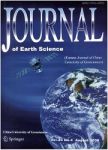Intricate Fault Systems in Longmenshan Structural Belt's Northern End:Exploring Structural Evolution and Seismic Rupture Behavior in the Eastern Tibetan Plateau
作者机构:State Key Laboratory of Earthquake DynamicsInstitute of GeologyChina Earthquake AdministrationBeijing 100029China State Key Laboratory of Oil and Gas Reservoir Geology and ExploitationInstitute of Sedimentary GeologyChengdu University of TechnologyChengdu 610059China College of Energy ResourcesChina University of GeosciencesBeijing 100083China PetroChina Research Institute of Petroleum Exploration and DevelopmentBeijing 100083China
出 版 物:《Journal of Earth Science》 (地球科学学刊(英文版))
年 卷 期:2025年第36卷第1期
页 面:250-265页
核心收录:
学科分类:070801[理学-固体地球物理学] 07[理学] 0708[理学-地球物理学]
基 金:supported by the National Key Research and Development Project of China(No.2021YFC3000600)
主 题:Longmenshan structural belt fault system structural evolution tectonics earthquakes focal mechanism
摘 要:The Longmenshan structural belt on the eastern edge of the Tibetan Plateau experienced the impactful Mw7.92008 Wenchuan Earthquake,causing a 350 km surface *** models attribute this to the Beichuan and Pengguan faults,but our research reveals a complex fault system at the northern end,with inconsistencies in surface rupture,aftershock distribution,and focal *** integrate shallow geology,active source seismic reflection,and magnetotelluric profiling to establish a deep structural model for the northern end of the Longmenshan structural *** area exhibits dominant reverse thrust nappe tectonics,and analyzing the tectonic evolution history provides insights into deformation propagation from the orogenic belt toward the Sichuan *** mechanism analysis and relocated aftershock data reveals two distinct types of seismogenic structures in the northern end of the Longmenshan structural *** the middle to northern segments,the reverse fault type is attributed to reactivated pre-existing ***,at the northern end,the strike-slip fault type originates from high-angle co-seismic rupture cutting through pre-existing reverse *** study enhances our understanding of fault complexity and seismic mechanisms in the northeastern Longmenshan structural belt,providing new insights into regional tectonics.




